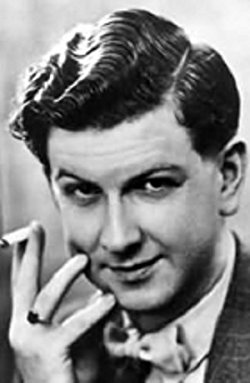
Cover of the US First Edition (Image Source)
The Moving Toyshop by Edmund Crispin was published in 1946, and is the third novel following the detective Gervase Fen. The main character, a poet named Richard Cadogan, accidentally comes across a dead body in a toy shop and is knocked out. When he wakes up, the toyshop has been replaced with a grocer and no one has any memory of the toyshop. To prove that he isn’t lying or insane, he enlists the help of Fen, who is a professor at Oxford and old classmate of his in order to discover the truth.2
They soon discover that the deceased woman, Emilia Tardy, was a traveler with few close connections, who was set to inherit a large sum of money from her aunt, Miss Snaith, also recently deceased. Snaith, who disapproved of her niece’s nomadic lifestyle, left specific instructions on how Tardy could claim the money in the news, which she knew she would not read, and left further instructions on who to give the money to instead if she did not claim it. These inheritors are known to Fen and Cadogan only by the nicknames Snaith gave them from The Nonsense Poems of Edward Lear, and the detectives must try to find these five mystery-people who each had an ample motive for murdering Miss Tardy.
Gervase Fen is an endearing and compelling character due to his enthusiasm and his eccentric quirks. He is a professor, about 40 years old, and is known for his spiky hair, raincoat, and sportscar named Lily Christine III. His relationship with Cadogan and their antics are reminiscent of a modern buddy-cop film, lending a great deal of the humor found in the novel as they rush around Oxford trying to solve the crime, interrupting Fen’s colleagues and breaking the law left and right.
Another significant contributor to the humor of the book is the metafictional elements, as characters occasionally discuss mystery tropes and conventions, or acknowledge the fact that they are in a mystery novel, particularly Fen who mentions Crispin by name.
“Fen steps in,” said Fen. “The Return of Fen. The Don Dares Death (A Gervase Fen Story).” … “I was making up titles for Crispin.” (65)2
In addition to the humor, the writing style is more literary and advanced than mystery fiction often is, though it continues the classic episodic format seen in the works of authors such as Buchan in The Thirty-Nine Steps. The book also has a few diagrams and maps to enhance the story, which is much appreciated.

A simplified map of Oxford from The Moving Toyshop (Image Source)
The novel fits neatly into the tradition of a cozy, with a small cast of characters, a limited setting, minimal violence, and an “impossible” locked-room mystery. Coincidences carry the plot along, such as when just the right suspect appears when Cadogan and Fen discuss the fact that they should talk to this person. Mysterious wills and riddles drive the mystery, and problems are solved primarily through intelligence rather than brute strength and violence. The heroes are friendly with the police but do not follow their advice, and instead break the law numerous times, almost mindlessly, in the pursuit of solving the case.
There has been one adaptation made of the novel, as part of the 1964 anthology series called Detective. In this 50 minute episode, Gervase Fen was portrayed by the actor Richard Wordsworth. Unfortunately, many episodes of this series were lost to time and so there are no adaptations that can feasibly be watched with ease.3
The novel has been well-received over the years, and it was a favorite of P.D. James. It currently has an average rating of 3.87 stars on Goodreads, and over two dozen editions and covers have been released over the 70+ years since its initial publication.6
“Edmund Crispin is one of the few mystery writers able to combine situation comedy and high spirits with detection.” -P.D. James5

Edmund Crispin (Image Source)
About the Author:
Edmund Crispin is pseudonym of Robert Bruce Montgomery, who was an organist, choirmaster, composer, crime reviewer, and prolific author. Montgomery was born October 2, 1921 in Buckinghamshire, and studied modern languages at St. John’s College in Oxford. He was part of the Detection Club, and published 9 novels and 2 short stories about Gervase Fen, which were inspired by John Dickson Carr and the cozy genre.7 He married Ann Clements very late in his life and died September 15, 1978 from an alcohol-related heart attack.1
Final Verdict: 4.75/5 Stars

I thoroughly enjoyed the book, and it felt fresh and different from the other mystery novels in the class. The humor and metafictional elements made it witty and unique, and are one of the biggest draws for the novel. The book has a distinctly British sense of humor, and will be enjoyable to readers who are looking for a lighter mystery. The characters are engaging and reading this novel will assuredly prompt the reader to look into the other novels in the Gervase Fen series.
References and Additional Resources
- Bargainnier, Earl F., ed. Twelve Englishmen of mystery. Popular Press, 1984.
- Crispin, Edmund. The Moving Toyshop. Bantam Books, 1946.
- “Detective (TV Series 1964–1969).” IMDb, IMDb.com, www.imdb.com/title/tt0397776/.
- Edmund Crispin – witty and classic detective fiction, Peters Fraser Dunlop, www.edmundcrispin.com/.
- James, P D. “Murder, They Wrote.” OpinionJournal – Five Best, Wall Street Journal, 3 June 2006, web.archive.org/web/20061022091015/http://www.opinionjournal.com/weekend/fivebest/?id=110008466.
- “The Moving Toyshop (Gervase Fen, #3).” The Moving Toyshop (Gervase Fen, #3) by Edmund Crispin, Goodreads, www.goodreads.com/book/show/831916.The_Moving_Toyshop.
- Priestman, Martin, ed. The Cambridge companion to crime fiction. Cambridge University Press, 2003.
- Winn, Dilys. Murder ink: the mystery reader’s companion. Workman Pub., 1977.
